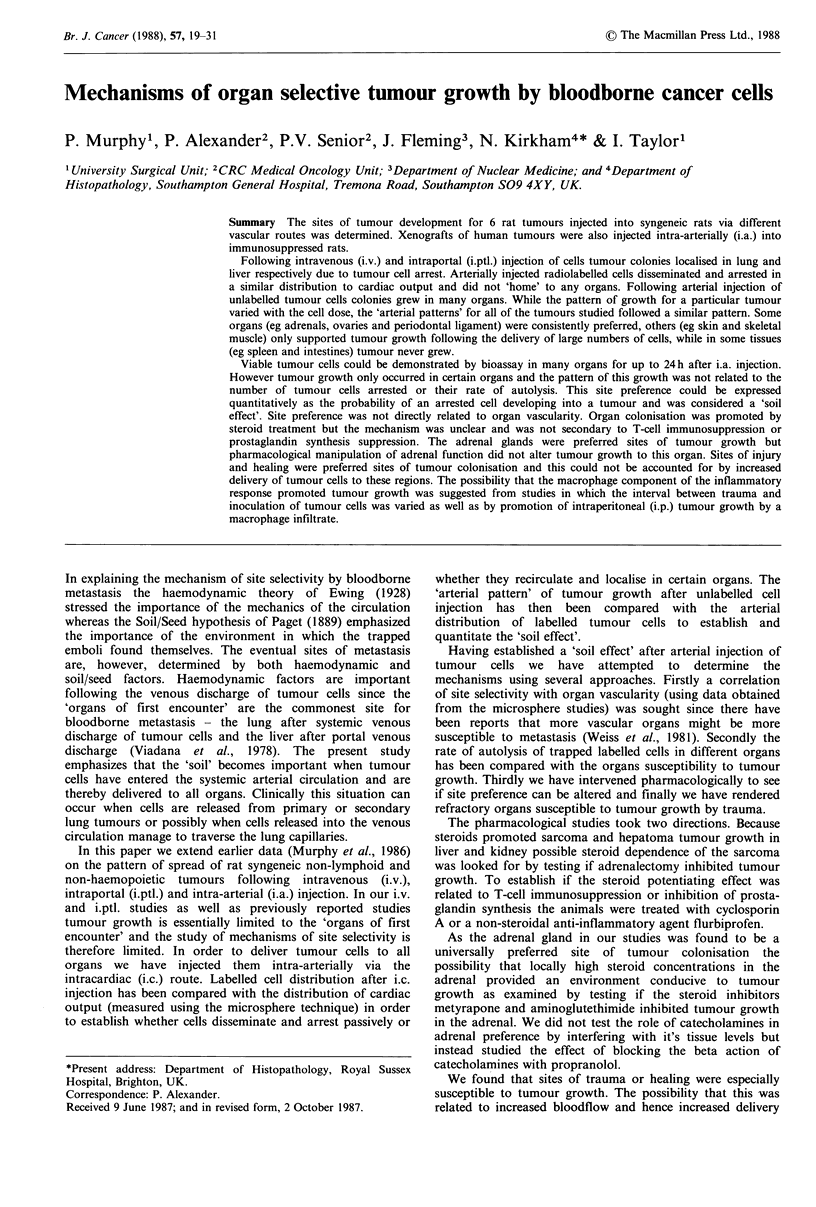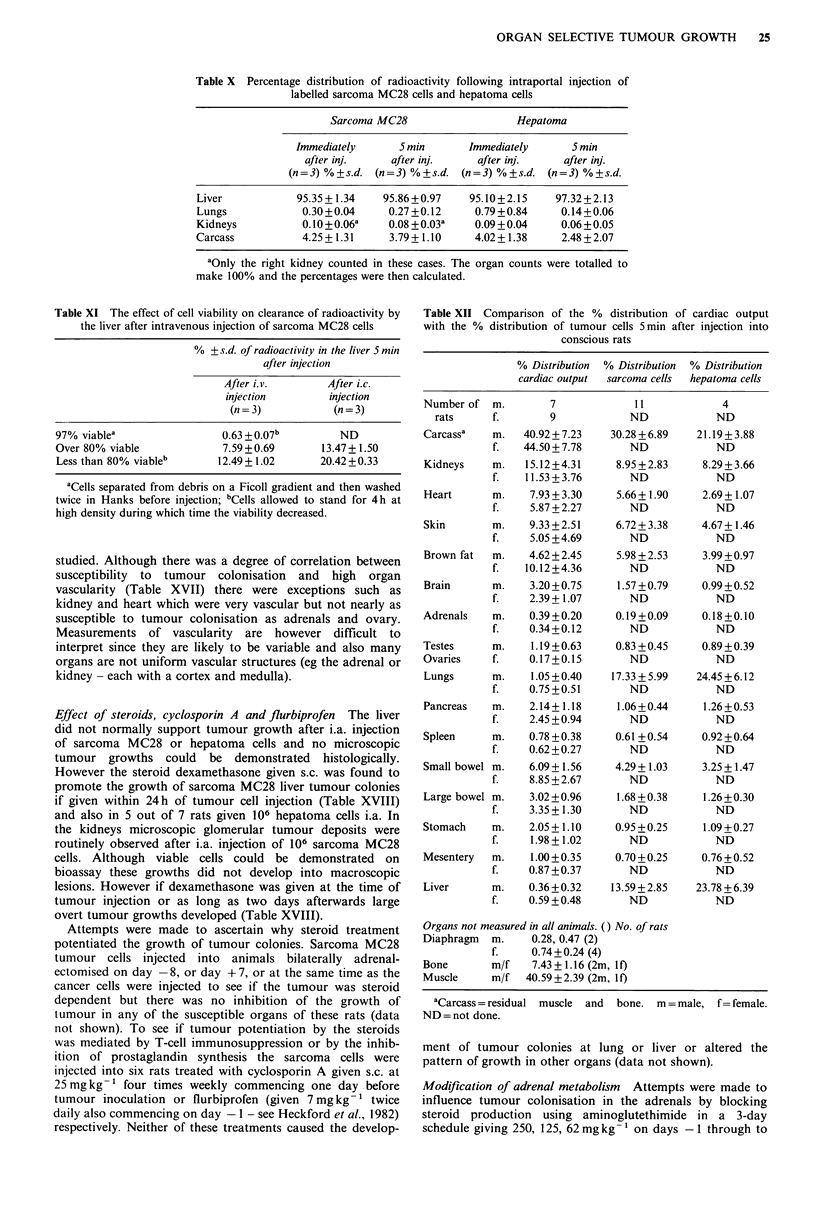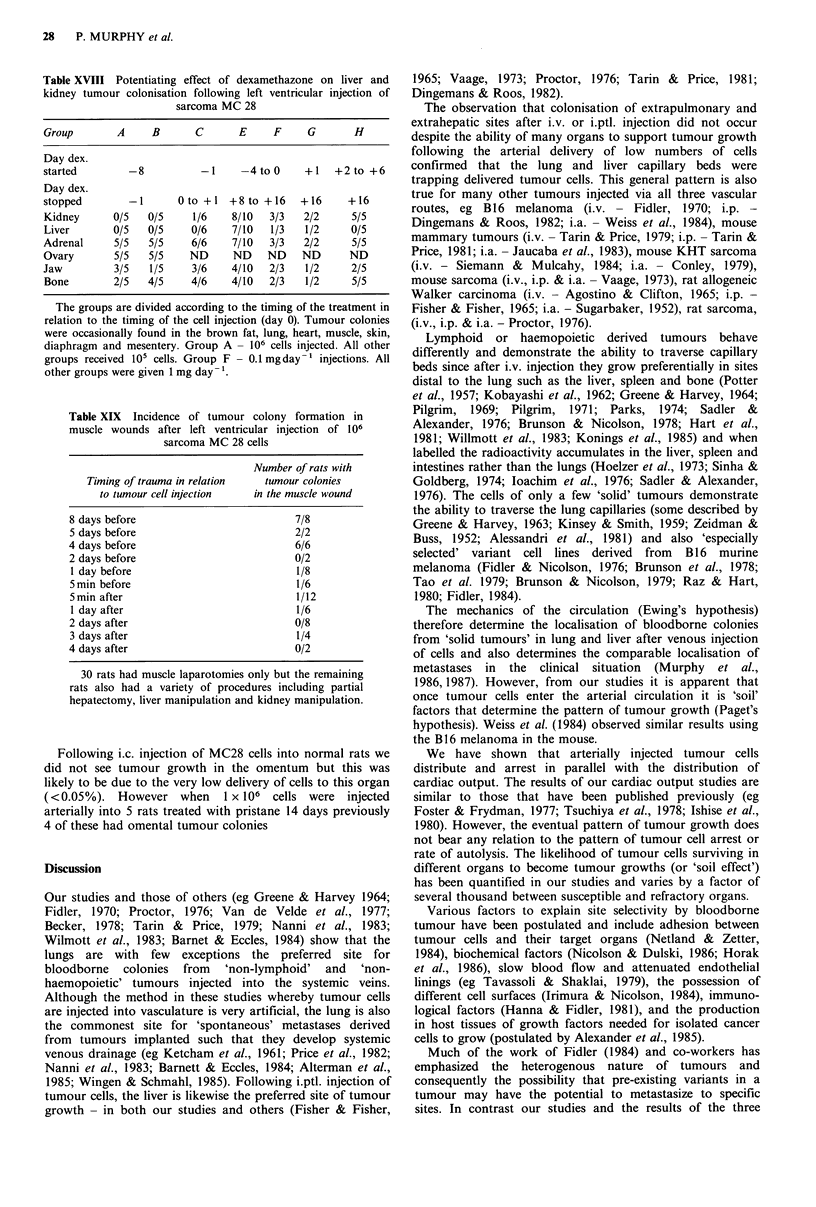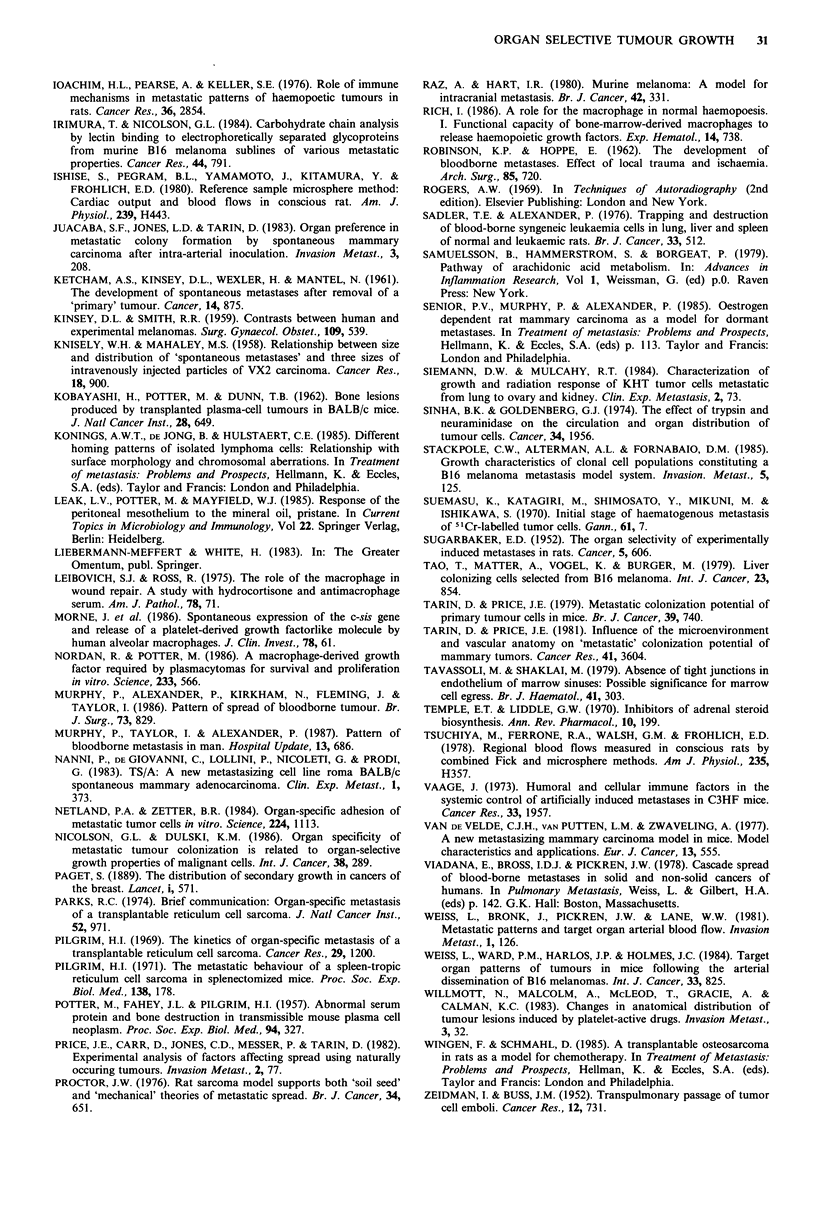Abstract
The sites of tumour development for 6 rat tumours injected into syngeneic rats via different vascular routes was determined. Xenografts of human tumours were also injected intra-arterially (i.a.) into immunosuppressed rats. Following intravenous (i.v.) and intraportal (i.ptl.) injection of cells tumour colonies localized in lung and liver respectively due to tumour cell arrest. Arterially injected radiolabelled cells disseminated and arrested in a similar distribution to cardiac output and did not 'home' to any organs. Following arterial injection of unlabelled tumour cells colonies grew in many organs. While the pattern of growth for a particular tumour varied with the cell dose, the 'arterial patterns' for all of the tumours studied followed a similar pattern. Some organs (eg adrenals, ovaries and periodontal ligament) were consistently preferred, others (eg skin and skeletal muscle) only supported tumour growth following the delivery of large numbers of cells, while in some tissues (eg spleen and intestines) tumour never grew. Viable tumour cells could be demonstrated by bioassay in many organs for up to 24h after i.a. injection. However tumour growth only occurred in certain organs and the pattern of this growth was not related to the number of tumour cells arrested or their rate of autolysis. This site preference could be expressed quantitatively as the probability of an arrested cell developing into a tumour and was considered a 'soil effect'. Site preference was not directly related to organ vascularity. Organ colonisation was promoted by steroid treatment but the mechanism was unclear and was not secondary to T-cell immunosuppression or prostaglandin synthesis suppression. The adrenal glands were preferred sites of tumour growth but pharmacological manipulation of adrenal function did not alter tumour growth to this organ. Sites of injury and healing were preferred sites of tumour colonisation and this could not be accounted for by increased delivery of tumour cells to these regions. The possibility that the macrophage component of the inflammatory response promoted tumour growth was suggested from studies in which the interval between trauma and inoculation of tumour cells was varied as well as by promotion of intraperitoneal (i.p.) tumour growth by a macrophage infiltrate.
Full text
PDF












Selected References
These references are in PubMed. This may not be the complete list of references from this article.
- ALEXANDER J. W., ALTEMEIER W. A. SUSCEPTIBILITY OF INJURED TISSUES TO HEMATOGENOUS METASTASES: AN EXPERIMENTAL STUDY. Ann Surg. 1964 Jun;159:933–944. doi: 10.1097/00000658-196406000-00010. [DOI] [PMC free article] [PubMed] [Google Scholar]
- Agostino D., Cliffton E. E. Organ localization and the effect of trauma on the fate of circulating cancer cells. Cancer Res. 1965 Nov;25(10):1728–1732. [PubMed] [Google Scholar]
- Alessandri G., Giavazzi R., Falautano P., Spreafico F., Garattini S., Mantovani A. A murine ovarian tumor with unique metastasizing capacity. Eur J Cancer. 1981 Jun;17(6):651–658. doi: 10.1016/0014-2964(81)90268-1. [DOI] [PubMed] [Google Scholar]
- Alexander P. Dormant metastases--studies in experimental animals. J Pathol. 1983 Nov;141(3):379–383. doi: 10.1002/path.1711410314. [DOI] [PubMed] [Google Scholar]
- Alexander P. The functions of the macrophage in malignant disease. Annu Rev Med. 1976;27:207–224. doi: 10.1146/annurev.me.27.020176.001231. [DOI] [PubMed] [Google Scholar]
- Alterman A. L., Fornabaio D. M., Stackpole C. W. Metastatic dissemination of B16 melanoma: pattern and sequence of metastasis. J Natl Cancer Inst. 1985 Oct;75(4):691–702. [PubMed] [Google Scholar]
- Barnett S. C., Eccles S. A. Studies of mammary carcinoma metastasis in a mouse model system. I: Derivation and characterization of cells with different metastatic properties during tumour progression in vivo. Clin Exp Metastasis. 1984 Jan-Mar;2(1):15–36. doi: 10.1007/BF00132304. [DOI] [PubMed] [Google Scholar]
- Becker F. F. Patterns of spontaneous metastasis of transplantable hepatocellular carcinomas. Cancer Res. 1978 Jan;38(1):163–167. [PubMed] [Google Scholar]
- Brunson K. W., Beattie G., Nicolsin G. L. Selection and altered properties of brain-colonising metastatic melanoma. Nature. 1978 Apr 6;272(5653):543–545. doi: 10.1038/272543a0. [DOI] [PubMed] [Google Scholar]
- Brunson K. W., Nicolson G. L. Selection and biologic properties of malignant variants of a murine lymphosarcoma. J Natl Cancer Inst. 1978 Dec;61(6):1499–1503. [PubMed] [Google Scholar]
- Brunson K. W., Nicolson G. L. Selection of malignant melanoma variant cell lines for ovary colonization. J Supramol Struct. 1979;11(4):517–528. doi: 10.1002/jss.400110410. [DOI] [PubMed] [Google Scholar]
- COMAN D. R., EISENBERG R. B., McCUTCHEON M. Factors affecting the distribution of tumor metastases; experiments with V2 carcinoma of rabbits. Cancer Res. 1949 Nov;9(11):649-51, illust. [PubMed] [Google Scholar]
- Conley F. K. Development of a metastatic brain tumor model in mice. Cancer Res. 1979 Mar;39(3):1001–1007. [PubMed] [Google Scholar]
- FISHER E. R., FISHER B. EXPERIMENTAL STUDY OF FACTORS INFLUENCING DEVELOPMENT OF HEPATIC METASTASES FROM CIRCULATING TUMOR CELLS. Acta Cytol. 1965 Mar-Apr;9:146–159. [PubMed] [Google Scholar]
- Fidler I. J. Metastasis: quantitative analysis of distribution and fate of tumor emboli labeled with 125 I-5-iodo-2'-deoxyuridine. J Natl Cancer Inst. 1970 Oct;45(4):773–782. [PubMed] [Google Scholar]
- Fidler I. J., Nicolson G. L. Organ selectivity for implantation survival and growth of B16 melanoma variant tumor lines. J Natl Cancer Inst. 1976 Nov;57(5):1199–1202. doi: 10.1093/jnci/57.5.1199. [DOI] [PubMed] [Google Scholar]
- Foster D. O., Frydman M. L. Comparison of microspheres and 86Rb+ as tracers of the distribution of cardiac output in rats indicates invalidity of 86Rb+-based measurements. Can J Physiol Pharmacol. 1978 Feb;56(1):97–109. doi: 10.1139/y78-014. [DOI] [PubMed] [Google Scholar]
- GREENE H. S., HARVEY E. K. THE RELATIONSHIP BETWEEN THE DISSEMINATION OF TUMOR CELLS AND THE DISTRIBUTION OF METASTASES. Cancer Res. 1964 Jun;24:799–811. [PubMed] [Google Scholar]
- Hart I. R., Talmadge J. E., Fidler I. J. Metastatic behavior of a murine reticulum cell sarcoma exhibiting organ-specific growth. Cancer Res. 1981 Apr;41(4):1281–1287. [PubMed] [Google Scholar]
- Heckford S. E., Eccles S. A., Powles T. J., Alexander P. Failure of short-term treatment with flurbiprofen to enhance the therapeutic effect of cyclophosphamide against rodent sarcomas and a leukaemia. Br J Cancer. 1982 Jul;46(1):51–57. doi: 10.1038/bjc.1982.164. [DOI] [PMC free article] [PubMed] [Google Scholar]
- Hoelzer D., Calvo W., Meyer-Hamme K. D., Harriss E. B. Cell distribution and proliferation pattern of a transferable acute leukemia in rats. J Natl Cancer Inst. 1973 Jun;50(6):1545–1553. doi: 10.1093/jnci/50.6.1545. [DOI] [PubMed] [Google Scholar]
- Horak E., Darling D. L., Tarin D. Analysis of organ-specific effects on metastatic tumor formation by studies in vitro. J Natl Cancer Inst. 1986 May;76(5):913–922. [PubMed] [Google Scholar]
- Ioachim H. L., Pearse A., Keller S. E. Role of immune mechanisms in metastatic patterns of hemopoietic tumors in rats. Cancer Res. 1976 Aug;36(8):2854–2862. [PubMed] [Google Scholar]
- Irimura T., Nicolson G. L. Carbohydrate chain analysis by lectin binding to electrophoretically separated glycoproteins from murine B16 melanoma sublines of various metastatic properties. Cancer Res. 1984 Feb;44(2):791–798. [PubMed] [Google Scholar]
- Ishise S., Pegram B. L., Yamamoto J., Kitamura Y., Frohlich E. D. Reference sample microsphere method: cardiac output and blood flows in conscious rat. Am J Physiol. 1980 Oct;239(4):H443–H449. doi: 10.1152/ajpheart.1980.239.4.H443. [DOI] [PubMed] [Google Scholar]
- Juacaba S. F., Jones L. D., Tarin D. Organ preferences in metastatic colony formation by spontaneous mammary carcinomas after intra-arterial inoculation. Invasion Metastasis. 1983;3(4):208–220. [PubMed] [Google Scholar]
- KETCHAM A. S., KINSEY D. L., WEXLER H., MANTEL N. The development of spontaneous metastases after the removal of a "primary" tumor. II. Standardization protocol of 5 animal tumors. Cancer. 1961 Jul-Aug;14:875–882. doi: 10.1002/1097-0142(199007/08)14:4<875::aid-cncr2820140425>3.0.co;2-6. [DOI] [PubMed] [Google Scholar]
- KINSEY D. L., SMITH R. R. Contrasts between human and experimental melanomas. Surg Gynecol Obstet. 1959 Nov;109:539–543. [PubMed] [Google Scholar]
- KNISELY W. H., MAHALEY M. S., Jr Relationship between size and distribution of spontaneous metastases and three sizes of intravenously injected particles of VX2 carcinoma. Cancer Res. 1958 Sep;18(8 Pt 1):900–905. [PubMed] [Google Scholar]
- KOBAYASHI H., POTTER M., DUNN T. B. Bone lesions produced by transplanted plasma-cell tumors in BALB/c mice. J Natl Cancer Inst. 1962 Mar;28:649–677. [PubMed] [Google Scholar]
- Leibovich S. J., Ross R. The role of the macrophage in wound repair. A study with hydrocortisone and antimacrophage serum. Am J Pathol. 1975 Jan;78(1):71–100. [PMC free article] [PubMed] [Google Scholar]
- Mornex J. F., Martinet Y., Yamauchi K., Bitterman P. B., Grotendorst G. R., Chytil-Weir A., Martin G. R., Crystal R. G. Spontaneous expression of the c-sis gene and release of a platelet-derived growth factorlike molecule by human alveolar macrophages. J Clin Invest. 1986 Jul;78(1):61–66. doi: 10.1172/JCI112574. [DOI] [PMC free article] [PubMed] [Google Scholar]
- Murphy P., Alexander P., Kirkham N., Fleming J., Taylor I. Pattern of spread of bloodborne tumour. Br J Surg. 1986 Oct;73(10):829–834. doi: 10.1002/bjs.1800731024. [DOI] [PubMed] [Google Scholar]
- Nanni P., de Giovanni C., Lollini P. L., Nicoletti G., Prodi G. TS/A: a new metastasizing cell line from a BALB/c spontaneous mammary adenocarcinoma. Clin Exp Metastasis. 1983 Oct-Dec;1(4):373–380. doi: 10.1007/BF00121199. [DOI] [PubMed] [Google Scholar]
- Netland P. A., Zetter B. R. Organ-specific adhesion of metastatic tumor cells in vitro. Science. 1984 Jun 8;224(4653):1113–1115. doi: 10.1126/science.6372098. [DOI] [PubMed] [Google Scholar]
- Nicolson G. L., Dulski K. M. Organ specificity of metastatic tumor colonization is related to organ-selective growth properties of malignant cells. Int J Cancer. 1986 Aug 15;38(2):289–294. doi: 10.1002/ijc.2910380221. [DOI] [PubMed] [Google Scholar]
- Nordan R. P., Potter M. A macrophage-derived factor required by plasmacytomas for survival and proliferation in vitro. Science. 1986 Aug 1;233(4763):566–569. doi: 10.1126/science.3726549. [DOI] [PubMed] [Google Scholar]
- POTTER M., FAHEY J. L., PILGRIM H. I. Abnormal serum protein and bone destruction in transmissible mouse plasma cell neoplasm (multiple myeloma). Proc Soc Exp Biol Med. 1957 Feb;94(2):327–333. doi: 10.3181/00379727-94-22035. [DOI] [PubMed] [Google Scholar]
- Parks R. C. Organ-specific metastasis of a transplantable reticulum cell sarcoma. J Natl Cancer Inst. 1974 Mar;52(3):971–973. doi: 10.1093/jnci/52.3.971. [DOI] [PubMed] [Google Scholar]
- Pilgrim H. I. The kinetics of the organ-specific metastasis of a transplantable reticuloendothelial tumor. Cancer Res. 1969 Jun;29(6):1200–1205. [PubMed] [Google Scholar]
- Pilgrim H. I. The metastatic behavior of a spleen-tropic reticulum cell sarcoma in splenectomized mice. Proc Soc Exp Biol Med. 1971 Oct;138(1):178–180. doi: 10.3181/00379727-138-35856. [DOI] [PubMed] [Google Scholar]
- Price J. E., Carr D., Jones L. D., Messer P., Tarin D. Experimental analysis of factors affecting metastatic spread using naturally occurring tumours. Invasion Metastasis. 1982;2(2):77–112. [PubMed] [Google Scholar]
- Proctor J. W. Rat sarcoma model supports both "soil seed" and "mechanical" theories of metastatic spread. Br J Cancer. 1976 Dec;34(6):651–654. doi: 10.1038/bjc.1976.227. [DOI] [PMC free article] [PubMed] [Google Scholar]
- ROBINSON K. P., HOPPE E. The development of blood-borne metastases. Effect of local trauma and ischemia. Arch Surg. 1962 Nov;85:720–724. doi: 10.1001/archsurg.1962.01310050022005. [DOI] [PubMed] [Google Scholar]
- Raz A., Hart I. R. Murine melanoma: a model for intracranial metastasis. Br J Cancer. 1980 Aug;42(2):331–341. doi: 10.1038/bjc.1980.235. [DOI] [PMC free article] [PubMed] [Google Scholar]
- Rich I. N. A role for the macrophage in normal hemopoiesis. I. Functional capacity of bone-marrow-derived macrophages to release hemopoietic growth factors. Exp Hematol. 1986 Sep;14(8):738–745. [PubMed] [Google Scholar]
- SUGARBAKER E. D. The organ selectivity of experimentally induced metastases in rats. Cancer. 1952 May;5(3):606–612. doi: 10.1002/1097-0142(195205)5:3<606::aid-cncr2820050324>3.0.co;2-u. [DOI] [PubMed] [Google Scholar]
- Sadler T. E., Alexander P. Trapping and destruction of blood-borne syngeneic leukaemia cells in lung, liver and spleen of normal and leukaemic rats. Br J Cancer. 1976 May;33(5):512–520. doi: 10.1038/bjc.1976.82. [DOI] [PMC free article] [PubMed] [Google Scholar]
- Siemann D. W., Mulcahy R. T. Characterization of growth and radiation response of KHT tumor cells metastatic from lung to ovary and kidney. Clin Exp Metastasis. 1984 Jan-Mar;2(1):73–81. doi: 10.1007/BF00132308. [DOI] [PubMed] [Google Scholar]
- Sinha B. K., Goldenberg G. J. The effect of trypsin and neuraminidase on the circulation and organ distribution of tumor cells. Cancer. 1974 Dec;34(6):1956–1961. doi: 10.1002/1097-0142(197412)34:6<1956::aid-cncr2820340614>3.0.co;2-g. [DOI] [PubMed] [Google Scholar]
- Stackpole C. W., Alterman A. L., Fornabaio D. M. Growth characteristics of clonal cell populations constituting a B16 melanoma metastasis model system. Invasion Metastasis. 1985;5(3):125–143. [PubMed] [Google Scholar]
- Suemasu K., Katagiri M., Shimosato Y., Mikuni M., Ishikawa S. Initial stage of hematogenous metastasis of Cr-labeled tumor cells. Gan. 1970 Feb;61(1):7–15. [PubMed] [Google Scholar]
- Tao T., Matter A., Vogel K., Burger M. M. Liver-colonizing melanoma cells selected from B-16 melanoma. Int J Cancer. 1979 Jun 15;23(6):854–857. doi: 10.1002/ijc.2910230618. [DOI] [PubMed] [Google Scholar]
- Tarin D., Price J. E. Influence of microenvironment and vascular anatomy on "metastatic" colonization potential of mammary tumors. Cancer Res. 1981 Sep;41(9 Pt 1):3604–3609. [PubMed] [Google Scholar]
- Tarin D., Price J. E. Metastatic colonization potential of primary tumour cells in mice. Br J Cancer. 1979 Jun;39(6):740–754. doi: 10.1038/bjc.1979.128. [DOI] [PMC free article] [PubMed] [Google Scholar]
- Tavassoli M., Shaklai M. Absence of tight junctions in endothelium of marrow sinuses: possible significance for marrow cell egress. Br J Haematol. 1979 Mar;41(3):303–307. doi: 10.1111/j.1365-2141.1979.tb05863.x. [DOI] [PubMed] [Google Scholar]
- Temple T. E., Liddle G. W. Inhibitors of adrenal steroid biosynthesis. Annu Rev Pharmacol. 1970;10:199–218. doi: 10.1146/annurev.pa.10.040170.001215. [DOI] [PubMed] [Google Scholar]
- Tsuchiya M., Ferrone R. A., Walsh G. M., Frohlich E. D. Regional blood flows measured in conscious rats by combined Fick and microsphere methods. Am J Physiol. 1978 Sep;235(3):H357–H360. doi: 10.1152/ajpheart.1978.235.3.H357. [DOI] [PubMed] [Google Scholar]
- Vaage J. Humoral and cellular immune factors in the systemic control of artifically induced metastases in C3Hf mice. Cancer Res. 1973 Aug;33(8):1957–1965. [PubMed] [Google Scholar]
- Van De Velde C. J., Van Putten L. M., Zwaveling A. A new metastasizing mammary carcinoma model in mice: model characteristics and applications. Eur J Cancer. 1977 Jun;13(6):555–565. doi: 10.1016/0014-2964(77)90117-7. [DOI] [PubMed] [Google Scholar]
- Weiss L., Bronk J., Pickren J. W., Lane W. W. Metastatic patterns and target organ arterial blood flow. Invasion Metastasis. 1981;1(2):126–135. [PubMed] [Google Scholar]
- Weiss L., Ward P. M., Harlos J. P., Holmes J. C. Target organ patterns of tumors in mice following the arterial dissemination of B16 melanoma cells. Int J Cancer. 1984 Jun 15;33(6):825–830. doi: 10.1002/ijc.2910330618. [DOI] [PubMed] [Google Scholar]
- Willmott N., Malcolm A., McLeod T., Gracie A., Calman K. C. Changes in anatomical distribution of tumour lesions induced by platelet-active drugs. Invasion Metastasis. 1983;3(1):32–51. [PubMed] [Google Scholar]
- ZEIDMAN I., BUSS J. M. Transpulmonary passage of tumor cell emboli. Cancer Res. 1952 Oct;12(10):731–733. [PubMed] [Google Scholar]


